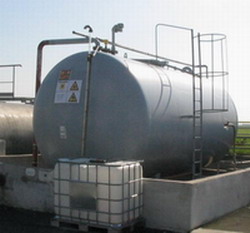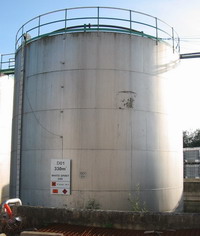Fixed roof tank model
Emissions from fixed roof tanks are a result of evaporative losses during storage (known as breathing losses) and evaporative losses during filling operations (known as working losses).
Typical fixed roof tank (horizontal and vertical) in chemical industry are presented below:


Breathing loss is the expulsion of vapour from a tank through vapour expansion and contraction, which are the results of changes in temperature and barometric pressure. This loss occurs without any liquid level change in the tank.
Working loss is a result of an increase in the liquid level in the tank.
Fixed roof tanks are either freely vented or equipped with a pressure/vacuum vent. The latter allows the tanks to operate at a slight internal pressure or vacuum to prevent the release of vapors during very small changes in temperature, pressure, or liquid level. It is also possible to inert tanks with small gas overpressure (using nitrogen for example).
Fixed roof tank emissions vary as a function of vessel capacity, vapour pressure of the stored liquid, utilization rate of the tank, and atmospheric conditions at the tank location.
Different hypothesis are assumed for the use of fixed roof tank model:
- Fixed roof tanks must be substantially liquid- and vapour-tight and must operate approximately at atmospheric pressure.
- The potential emission sources for above-ground horizontal tanks are the same as those for vertical fixed roof tanks. Emissions from underground storage tanks are associated mainly with changes in the liquid level in the tank. In that case breathing loss can be neglected (losses are minimal for underground tanks because the surrounding earth limits the diurnal temperature change).
- In order to limit working losses, vapour balancing is commonly used. As the storage tank is filled, the vapors expelled from the storage tank are directed to the emptying tanker truck. The truck then transports the vapors to a station where a vapour recovery or control system is used to control emissions. In that case working loss can be neglected.
Example:
On one industrial platform located in Paris, France (Min - Max temperature = 9.8 - 14.1 °C ; solar insolation factor = 900 J/cm2.day) a vertical fixed flat roof tank (diameter = 2 m, height = 5 m) is used to store MEK. The tank is uniformly white painted (alpha = 0.17) and is atmospheric vented.
Average liquid height is 2.5 m. Yearly MEK throughput is 550 m3.
Annual atmospheric calculated emissions are:
- Total loss : 127.13 kg
- Breathing loss : 11.67 kg
- Working loss : 115.46 kg



